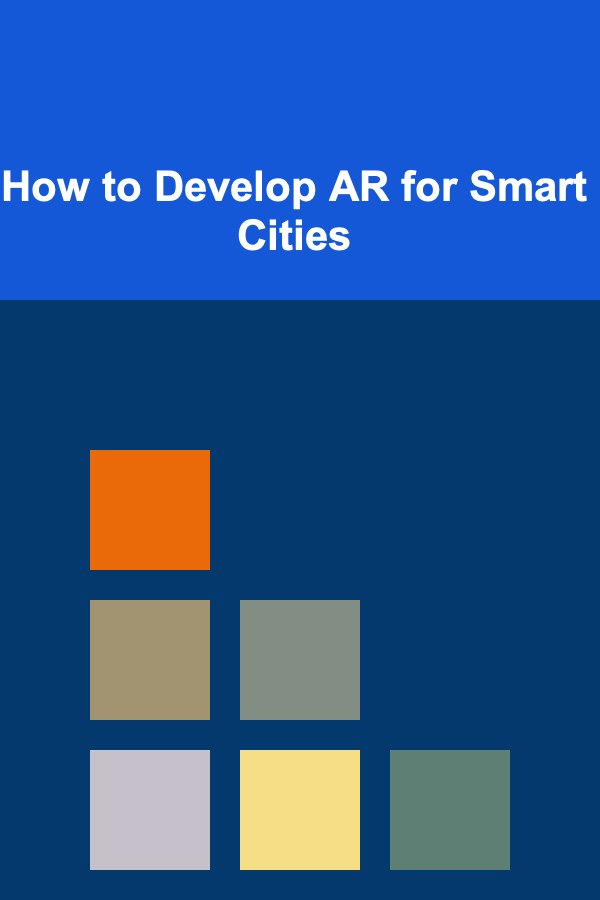
How to Develop AR for Smart Cities
ebook include PDF & Audio bundle (Micro Guide)
$12.99$9.99
Limited Time Offer! Order within the next:

The integration of Augmented Reality (AR) in the context of smart cities is one of the most exciting and transformative technological advancements of recent years. Smart cities, characterized by their use of digital technologies and data to improve the quality of life for their residents, are perfectly suited to benefit from the immersive and interactive nature of AR. This article explores the development of AR for smart cities, outlining the technology's potential applications, challenges, and best practices for creating successful AR experiences in urban environments.
What is Augmented Reality (AR)?
Augmented Reality is an interactive experience that enhances the real-world environment by superimposing digital elements---such as images, sounds, or data---onto the user's view of the physical world. Unlike Virtual Reality (VR), which creates entirely immersive digital environments, AR blends the virtual with the real. This creates an experience where digital information interacts with the physical world in real-time, offering a seamless enhancement to what we see and experience.
AR uses devices such as smartphones, tablets, and AR glasses to overlay these digital elements on the physical world. These elements can provide additional context, information, or functionalities that enrich the user's experience.
The Role of AR in Smart Cities
Smart cities are urban environments that leverage technology to improve infrastructure, services, and overall quality of life. They integrate Internet of Things (IoT) devices, data analytics, and other technologies to optimize city functions, from transportation systems to healthcare services. AR is becoming a powerful tool in this context because it has the potential to provide real-time, location-based information that enhances urban living in a multitude of ways.
Key Areas Where AR Can Enhance Smart Cities:
-
Urban Planning and Development: AR allows city planners and architects to visualize buildings, infrastructure, and landscapes in real-time. By overlaying 3D models of buildings and streets onto the actual site, they can assess design proposals, identify potential issues, and optimize space utilization. It helps to bridge the gap between conceptual designs and their real-world applications.
-
Navigation and Wayfinding: In smart cities, AR-powered navigation can enhance how people interact with urban spaces. Through AR-enabled smartphones or AR glasses, users can get real-time, step-by-step directions, visualized directly in the physical environment. This can be particularly useful in complex environments like airports, large shopping malls, or busy city streets, where traditional maps or signage may be difficult to follow.
-
Tourism and Cultural Experiences: For tourists in smart cities, AR can transform sightseeing. Through AR apps, users can access historical information, virtual guides, and interactive features at various landmarks. By overlaying virtual objects or information on physical sites, tourists can gain a richer understanding of the location's history, culture, and significance.
-
Public Services and Safety: AR can enhance public safety and service delivery in smart cities by providing real-time data to citizens and city officials. For instance, AR could assist firefighters by displaying building layouts or escape routes during emergency responses. It could also be used for maintenance workers to visually identify faults in infrastructure like water pipes or electrical lines. Additionally, AR applications could alert citizens to hazards like traffic accidents, air pollution levels, or public safety risks.
-
Transport and Traffic Management: One of the most significant uses of AR in a smart city is in the management of transportation systems. AR can provide drivers and pedestrians with real-time traffic updates, congestion information, and alternative routes. Public transportation systems could also benefit from AR through interactive bus stops or subway stations, where users can check schedules, track routes, and receive live updates on delays or other issues.
-
Education and Training: AR provides immersive learning experiences that can be used for educational purposes within smart cities. Schools and universities can utilize AR to create interactive lessons that involve real-world contexts. AR could also be used to provide training for city employees, enabling them to interact with real-time data and simulations of city operations.
Potential Benefits of AR for Smart Cities:
- Enhanced User Experience: By making interactions with urban environments more intuitive and engaging, AR helps citizens and visitors navigate and experience the city in novel ways.
- Improved Decision Making: With AR, real-time data overlays can provide citizens and city officials with up-to-date information, improving decision-making processes in areas like traffic management, public health, and urban development.
- Increased Efficiency: The use of AR in city services can streamline operations by improving workflows, facilitating real-time maintenance, and enabling more efficient urban planning and resource allocation.
- Boosted Civic Engagement: AR can encourage greater participation in public projects by allowing residents to engage with real-time data, provide feedback on urban development, and contribute to decision-making processes in a more direct and interactive manner.
Steps to Develop AR for Smart Cities
The development of AR applications for smart cities requires a combination of software development, hardware integration, and deep understanding of urban infrastructure and needs. Here's a step-by-step guide to developing AR for smart cities:
1. Define the Problem and Identify Use Cases
The first step in developing AR for a smart city is identifying the specific urban challenges that AR can address. These challenges might include inefficient transportation systems, overcrowded public spaces, lack of real-time information, or inadequate public safety protocols. By identifying the problem, developers can prioritize use cases where AR will have the most significant impact. Potential use cases might include:
- Real-time transportation updates for commuters
- Smart navigation for pedestrians and cyclists
- Augmented urban tourism experiences
- Real-time city infrastructure monitoring for maintenance teams
Understanding the problem thoroughly helps developers design solutions that are practical, scalable, and valuable to the end-users.
2. Choose the Right AR Platform and Tools
AR development requires specialized tools and platforms. The choice of tools will depend on the use cases, the level of interactivity, and the target devices. There are several platforms available for AR development, such as:
- ARCore (Google): For Android-based AR experiences, ARCore is a popular choice. It supports motion tracking, environmental understanding, and light estimation, allowing developers to create interactive AR apps.
- ARKit (Apple): For iOS-based AR development, ARKit is the go-to platform. It allows developers to create rich AR experiences for iPhones and iPads.
- Unity and Unreal Engine: These game engines can be used to create immersive AR environments and integrate 3D models with real-world imagery.
- Vuforia: A comprehensive AR development platform that can be used for both Android and iOS apps, Vuforia provides tools for object recognition, image tracking, and spatial awareness.
The selection of the platform should align with the city's infrastructure, the devices the population uses (e.g., smartphones, tablets, AR glasses), and the specific AR features that are required.
3. Design and Develop the AR Application
With the problem and tools defined, the next step is designing and developing the AR application. The design should focus on the following principles:
- User-Centric Design: The app should be intuitive and easy to use. It should provide relevant and actionable information, allowing users to interact seamlessly with the urban environment.
- Real-Time Data Integration: To make AR useful in smart cities, real-time data feeds must be integrated into the app. For instance, traffic information, pollution levels, or maintenance schedules should be pulled in dynamically from IoT devices or public databases.
- Location-Based Services: AR in smart cities relies heavily on location-based services. The application should be able to access geospatial data accurately, such as GPS, maps, and urban data layers.
- Scalability and Performance: The AR system must be scalable to handle large cities with complex data streams. Developers need to ensure that the app can handle real-time processing and display data efficiently, even in high-traffic areas.
4. Test and Validate the Application
Testing is a critical phase in the development of any AR application. The app should be tested in real-world environments to ensure that the AR features function as expected in various settings. Testing should focus on:
- Accuracy: Does the AR overlay align correctly with the real-world objects or locations?
- Performance: Does the app run smoothly on different devices, particularly in areas with high user traffic?
- Usability: Is the app user-friendly? Do users find it easy to navigate the city using the AR interface?
Beta testing can help gather valuable user feedback and identify areas for improvement before a full-scale rollout.
5. Deploy and Monitor
Once the application is tested and refined, it is time to deploy it in the real world. For smart city AR apps, deployment often involves coordination with city authorities, transportation departments, and other relevant entities to ensure that data is accurately integrated and accessible.
Ongoing monitoring is essential to ensure that the application remains functional and relevant. This involves collecting feedback from users, analyzing data usage, and making necessary updates based on the evolving needs of the city and its residents.
Challenges in Developing AR for Smart Cities
While AR has enormous potential, there are several challenges that developers and city planners must address to create successful AR experiences in smart cities.
1. Data Privacy and Security
AR applications often rely on real-time data, such as location tracking and personal user information. Ensuring that this data is protected is a critical issue, especially when dealing with sensitive information. Developers must implement robust data privacy and security measures to prevent misuse and protect user data.
2. Infrastructure Limitations
Not all urban areas are equipped with the necessary infrastructure to support AR. High-speed internet, reliable GPS, and powerful devices are essential for delivering a smooth AR experience. In some cities, these technologies might not be readily available, which could limit the effectiveness of AR applications.
3. User Adoption and Accessibility
While AR technology is becoming more accessible, it still requires a certain level of technological literacy. Developers must design intuitive interfaces that can be used by a wide range of citizens, including those who are not technologically savvy. Ensuring that the app is accessible to people with disabilities is also important for broader adoption.
4. High Development and Maintenance Costs
Developing and maintaining AR applications for smart cities is an expensive undertaking. Cities must be willing to invest in both the initial development and the ongoing costs of system updates, data management, and infrastructure upgrades.
Conclusion
Developing AR for smart cities has the potential to revolutionize urban living. By enhancing city services, improving transportation systems, and providing citizens with real-time, interactive experiences, AR can contribute to making cities more efficient, sustainable, and enjoyable places to live. However, it requires careful planning, investment, and collaboration between developers, city authorities, and other stakeholders to successfully integrate AR into the urban fabric.
As the world continues to embrace smart city initiatives, AR will undoubtedly play a key role in shaping the future of cities, transforming them into dynamic, interactive, and intelligent environments that respond to the needs of their residents in real-time.

How to Make Money on Live Streaming Platforms
Read More
How to Use Bookends and Decorative Items for Organization
Read More
How To Research the Long-Term Environmental Benefits of Electric Vehicles (EVs)
Read More
How to Let ChatGPT Help You Learn Foreign Languages
Read More
How to Embrace Adversity with Stoic Acceptance
Read More
How to Lower Your Utility Bills
Read MoreOther Products

How to Make Money on Live Streaming Platforms
Read More
How to Use Bookends and Decorative Items for Organization
Read More
How To Research the Long-Term Environmental Benefits of Electric Vehicles (EVs)
Read More
How to Let ChatGPT Help You Learn Foreign Languages
Read More
How to Embrace Adversity with Stoic Acceptance
Read More